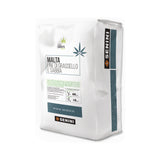Hempcrete Frequently Asked Questions
Hempcrete is a sustainable building material made from hemp fibers, lime, and water. It has gained popularity for its eco-friendly properties and energy efficiency.
Hempcrete is a biocomposite material made from hemp fibers, lime binder, and water. It is used primarily as an insulating infill material in building construction. Unlike concrete, it does not always have load bearing structural strength but is excellent for insulation and thermal performance.
Hempcrete is made by mixing hemp hurd (the woody core of the hemp plant) with a lime-based binder and water. This mixture is then cast into blocks, forms or used as infill between structural elements such as timber frames, steel or concrete.
• Sustainability: Hemp is a rapidly renewable resource and can absorb CO2 during its growth, making hempcrete a low-carbon material.
• Insulation: Hempcrete provides excellent thermal insulation and can help regulate indoor temperatures.
• Moisture Control: It has good moisture-regulating properties, helping to manage humidity and reduce the risk of mold.
• Fire Resistance: Hempcrete is non-combustible and has a high fire resistance.
• Durability: When properly maintained, hempcrete can last for many decades.
Hempcrete is not known as a structural material. It is used as an insulating infill material and relies on a structural frame (such as timber, steel or concrete) to bear the load of the building.
• Environmental Impact: Hempcrete has a much lower carbon footprint compared to traditional concrete. Hemp absorbs CO2 as it grows, whereas cement production is a major source of CO2 emissions.
• Insulation: Hempcrete offers better insulation properties than traditional concrete, which can lead to energy savings on heating and cooling.
• Weight: Hempcrete is lighter than traditional concrete, which can reduce the load on the building's structural elements.
Hempcrete performs well in a variety of climates. Its moisture-regulating properties make it suitable for both humid and dry conditions. However, it is essential to ensure proper design and installation to handle extreme weather conditions.
Hempcrete typically sets in about 24-48 hours, but it continues to cure and gain strength over time. Full curing can take several months, during which the lime binder reacts with CO2 from the air to harden.
Hempcrete is typically installed in layers between timber, metal or concrete frames. It can be cast on-site or pre-fabricated in panels. The material is packed tightly into the frames and allowed to cure before any finishing work is done.
Hempcrete is low-maintenance. It is important to ensure that it remains dry and is protected from heavy, continuous water exposure. Lime plasters & renders will also ensure protection from extreme weather conditions.
The initial cost of hempcrete can be slightly higher than traditional materials due to the cost of materials and installation. However, its benefits in terms of energy efficiency and durability can offset these costs over a short period of time, leading to long-term savings.
Hempcrete is biodegradable and can be recycled or disposed of in an environmentally friendly manner. It does not release harmful chemicals when it decomposes.
For more information, you can contact us here in GraHemp.ie We have connections to many architects and builders who are knowledgeable about hempcrete and can also provide guidance on its use in construction.








